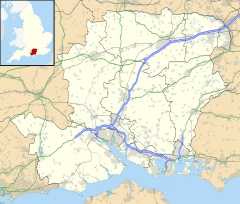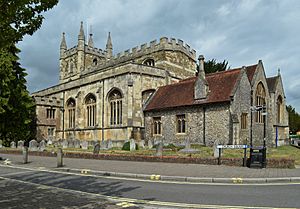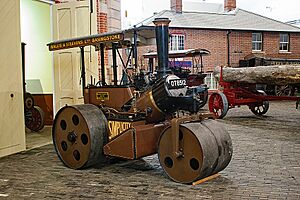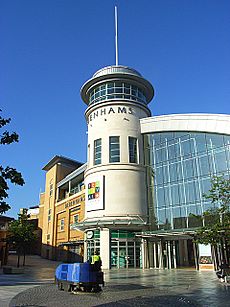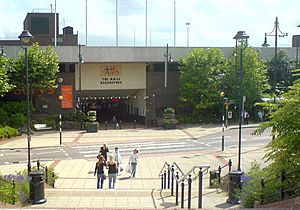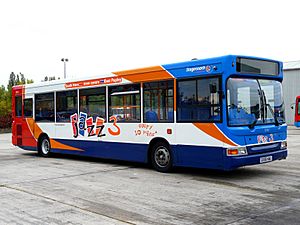Basingstoke facts for kids
Quick facts for kids Basingstoke |
|
|---|---|
| Town | |
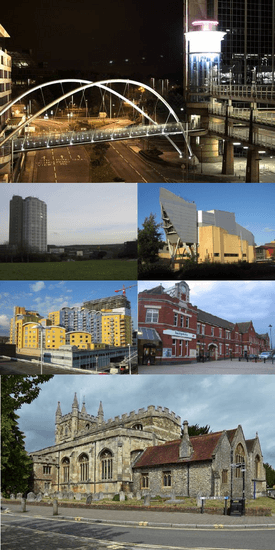 Clockwise from top: Town centre viewed from Churchill Way at night, The Anvil theatre, Basingstoke railway station, St Michael's Church, high-rise flats in Crown Heights, and the AA Building (Fanum House) |
|
| Population | 113,776 |
| OS grid reference | SU637523 |
| District |
|
| Shire county | |
| Region | |
| Country | England |
| Sovereign state | United Kingdom |
| Post town | Basingstoke |
| Postcode district | RG21–RG24 |
| Dialling code | 01256 |
| Police | Hampshire |
| Fire | Hampshire |
| Ambulance | South Central |
| EU Parliament | South East England |
| UK Parliament |
|
Basingstoke is a lively town in Hampshire, England. It sits in a valley where the River Loddon begins, on the western edge of the North Downs. It is the biggest town in Hampshire that doesn't have city status.
Basingstoke is about 48 miles (77 km) southwest of London. It's also near other important towns like Southampton and Winchester. In 2016, about 113,776 people lived here. The town is part of the Basingstoke and Deane area.
Basingstoke was once a small market town. It grew very quickly in the 1960s. This happened because of a plan to help people move out of crowded London. Even though it's much bigger now, Basingstoke still has a regular market.
Today, Basingstoke is an important place for business. Many big companies have their UK or European offices here. These include companies in IT, telecommunications, and electronics.
Contents
What's in a Name? The Meaning of Basingstoke
The name Basingstoke probably comes from its location. It was the westernmost settlement of a group of people called "Basa's people." A nearby village, Old Basing, has a similar name. It was the original home of the "Basingas," led by a chief named Basa. Basingstoke became more important when the main church moved there.
Exploring Basingstoke's Past
Ancient Times: Early Settlements
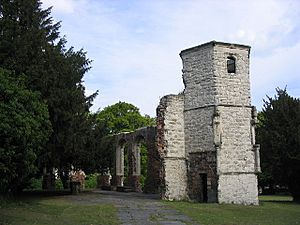
People have lived in the Basingstoke area for a very long time. The earliest known settlement was a campsite from around 3000 BC. Tools and axes found here date back even further. There's an Iron Age hillfort called Winklebury nearby.
Ancient Roman roads also crossed through this area. One ran from Winchester to Silchester. Another went from Chichester through nearby villages. The Harrow Way, an ancient path, also passes south of the town. The first big historical event here was a battle in 871. King Æthelred of Wessex and Alfred the Great were defeated by the Danes at Old Basing.
From Market Town to Modern Growth
Basingstoke has been a market town for centuries. It was first mentioned in the Domesday Book in 1086. It has had a regular market every Wednesday since 1214.
During the Civil War (1643-1645), the town saw a lot of action. St. Michael's Church was damaged. The roof of the Chapel of the Holy Ghost was removed, leading to its ruin. The town also suffered from big fires in 1601 and 1656.
For a long time, the cloth industry was important here. Later, brewing became a major business in the 1700s and 1800s. May's Brewery, started in 1750, was very successful.
Victorian Era: Railways and Industry
The London and South Western Railway arrived in Basingstoke in 1839. This connected the town to London and Southampton. Other railway lines soon followed. In the 1850s, Basingstoke started making industrial goods. Companies like Wallis & Steevens began producing farm equipment and steam engines.
Two famous businesses started here in the 1850s. Thomas Burberry opened his first shop in 1856. He became famous for inventing Gabardine fabric. Alfred Milward started his shoe shop in 1857.
John May, from the brewing family, was a generous person. He paid for a drill hall and a hospital wing. He also bought land for the Basingstoke Cricket Club, which is still used today.
In 1880, the Salvation Army arrived in town. Their methods caused some upset, especially among those involved in the alcohol trade. There were even clashes, and troops had to be called in once.
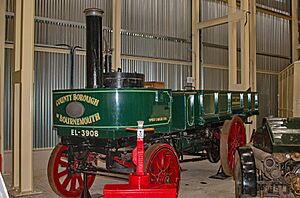
By 1898, John Isaac Thornycroft started making steam-powered lorries. His company, Thornycroft, quickly became the town's biggest employer.
Recent Times: Growth and Modern Basingstoke
Basingstoke was lucky during the Second World War. It had very little bomb damage. After the war, the town had about 25,000 people.
As part of the "London Overspill" plan, Basingstoke grew rapidly in the 1960s. Many new homes and offices were built. A ring road was also constructed around the town centre. The shopping centre was built in stages. The main part, Festival Place, opened in 2002. This greatly improved shopping in the town.
Where is Basingstoke?
Basingstoke is in a valley within the Hampshire Downs. It's about 88 meters (289 feet) above sea level. It's a key meeting point for roads connecting to Reading, Winchester, and London. This area has been important for trade routes for thousands of years.
Town Areas and Neighborhoods
Basingstoke has grown a lot, taking in nearby farms and small groups of houses. These areas have become new neighborhoods or housing estates. Some of these include Chineham, Popley, and Hatch Warren. The M3 motorway forms a boundary to the south.
How Basingstoke is Run
Basingstoke has a two-part local government system. It sends councillors to Hampshire County Council. The Basingstoke and Deane Borough Council manages local services for the town.
Basingstoke is also "twinned" with other towns in Europe. These are Alençon in France, Braine-l'Alleud in Belgium, and Euskirchen in Germany. This helps build friendships and understanding between different places.
Things to Do and See
Shopping and Entertainment
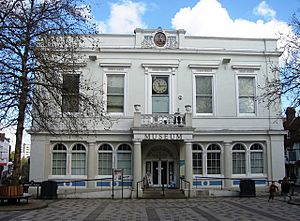
The "Top of Town" is the historic part of Basingstoke. Here you'll find the Willis Museum, located in the old Town Hall. The museum has many items about local history. A statue of famous author Jane Austen is outside the museum.
The main shopping area is Festival Place, which opened in 2002. It has many shops, cafes, restaurants, and a large Vue cinema.
Another shopping area is The Malls, which is connected to the railway station. It was updated in 2011.
For evening fun, Basingstoke has places in Festival Square and traditional pubs in the Top of Town. There are also several nightclubs.
Sports and Leisure
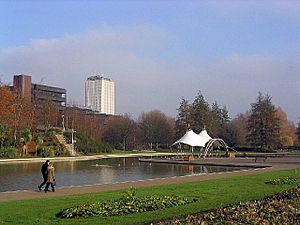
The Basingstoke Sports Centre offers a swimming pool, gym, and squash courts.
Outside the town centre, there's a big leisure park. It has the Aquadrome swimming pool, an ice rink, a bowling alley, and an indoor sky-diving centre. There's also an Odeon cinema.
The leisure park is also home to the Milestones Museum. This is a living history museum where you can explore streets and buildings from Hampshire's past.
Basingstoke has many sports teams. These include the football club, the rugby team, and the Basingstoke Bison ice hockey team. There are also swimming, American Flag Football, and roller derby teams.
Music and Media
Basingstoke has various musical groups, from brass bands to symphony orchestras. The Basingstoke Concert Band has been playing for over 35 years.
The town has two local newspapers: the Basingstoke Gazette and the Basingstoke Observer. Local TV news comes from BBC South and ITV Meridian. There are also several radio stations available.
Learning in Basingstoke
Education in Basingstoke is managed by Hampshire County Council. Each neighborhood has at least one primary school. Secondary schools are located on larger campuses around the town.
Basingstoke has two main colleges for further education. These are Queen Mary's College (a sixth form college) and Basingstoke College of Technology (BCoT).
Getting Around Basingstoke
Roads
Basingstoke is very close to the M3 motorway. This road connects the town to London in the northeast and Southampton in the southwest. The town centre has a ring road called The Ringway, built in the 1960s. Other main roads connect Basingstoke to Reading, Winchester, and Salisbury.
Trains
Basingstoke railway station is in the town centre. It connects Basingstoke to London Waterloo, Winchester, Southampton, and Exeter. There are also trains to Reading and further north. Train services are run by South Western Railway, CrossCountry, and Great Western Railway.
Buses
Most bus services start from Basingstoke bus station. Stagecoach Group provides most of these services. National Express also offers direct coach services to London and Southampton.
Cycling
Basingstoke has an extensive network of cycle routes. These routes are mainly on roads or run alongside them. Basingstoke is part of the National Cycle Network, connecting it to Reading and Alton.
Basingstoke Canal
The Basingstoke Canal once started in the town centre. It ran alongside the River Loddon. While parts of the canal are no longer navigable, a section from Up Nately to the Greywell Tunnel is a nature reserve. You can walk along the canal towpath there. There are plans to create a footpath and cycleway along the old canal route.
Places of Worship
- The Anglican church of St. Michael's is an old church, with parts dating back to 1464.
- The ruined Chapel of the Holy Ghost was built in 1524. It is no longer used for worship but is surrounded by an ancient cemetery.
- The Catholic Holy Ghost Church was built in 1902 and is a Grade II listed building.
- Other churches include St Mary, All Saints', and St Peter's. There are also churches of other Christian groups in the town.
Town Partnerships
Basingstoke is twinned with:
- Braine-l'Alleud, Belgium
- Alençon, France
- Euskirchen, Germany
Basingstoke in Books and Films
Basingstoke has appeared in various stories. In the 1887 opera Ruddigore, "Basingstoke" is a secret code word. Thomas Hardy called Basingstoke "Stoke Barehills" in his 1895 novel Jude the Obscure.
Basingstoke's North Hampshire Hospital was used for filming the TV comedy Green Wing. The film He Snoops to Conquer (1944) was partly shot in the town. The 1998 film Get Real was also filmed in Basingstoke.
Famous People from Basingstoke
Many notable people have connections to Basingstoke. These include the naturalist Revd. Gilbert White and cricket commentator John Arlott. More recently, art critic Waldemar Januszczak and actress Elizabeth Hurley are from the town.
See also
 In Spanish: Basingstoke para niños
In Spanish: Basingstoke para niños


